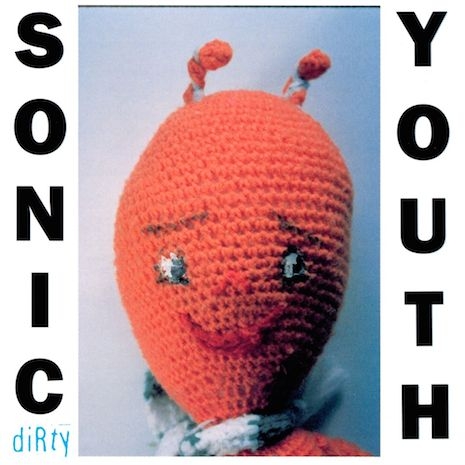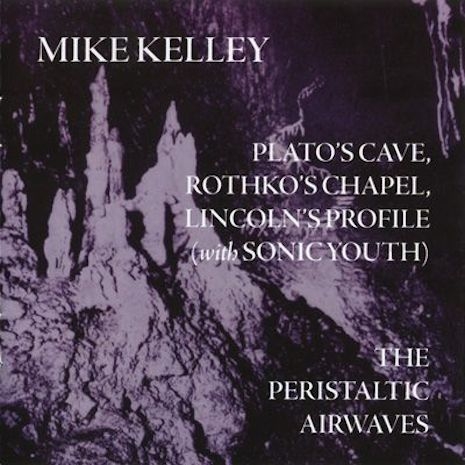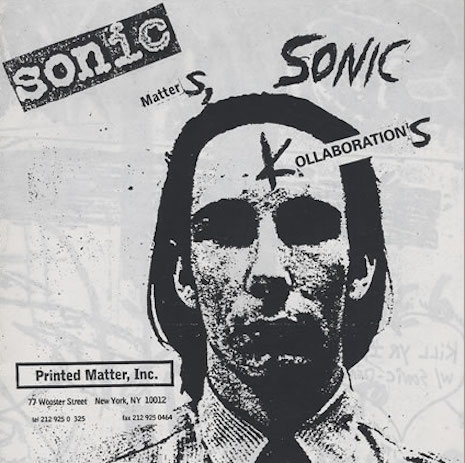
The first time I visited New York’s SoHo district in 1992 I remember seeing a large print of the cover art for Sonic Youth’s Dirty hanging in a loft window. Earlier that year, my art teacher had complained about Sonic Youth’s use of Mike Kelley’s “Ahh. . . Youth!” on the Dirty sleeve, so I probably wouldn’t have been surprised to learn that Kelley had fronted the band during a 1986 performance.
In the mid-‘80s, Kelley worked on a project called Plato’s Cave, Rothko’s Chapel, Lincoln’s Profile. It consisted of a series of paintings, a cave-like installation called The Trajectory of Light in Plato’s Cave, and a poetic text. The project culminated a December 1986 performance of the text by Kelley and an actress named Molly Cleator, backed by Sonic Youth.

Alec Foege’s old Sonic Youth bio Confusion Is Next gives some background on the collaboration:
In December 1986 Kelly invited the band to provide sound effects and incidental music for three performances of his piece Plato’s Cave, Rothko’s Chapel, Lincoln’s Profile at Artists Space in New York. Kelley recited an hour-and-a-half poem he had written and dramatized with the help of actress Molly Cleator while the band droned on.
Plato’s Cave had begun “as a project about the possessive,” Kelley said in one interview, “about how ascribing a quality of possession to something would equalize everything. Like, if I said that this was an exhibition of everything from Lincoln’s house, it links all this random stuff together that has no link except as a possible way to psychoanalyze Lincoln. Everybody asked me why I picked those three people. I made a whole list of possessives that were in common usage and I just picked the three that sounded best together. . . . Then I wove a set of associations between them.”
The band got together with Kelley a couple days before the performance. Kelley went through the script and told the band what he wanted at certain cues—a chunky rock sound, a bang, a spooky noise.
“I wanted to play with rock staging,” Kelley says. “For a lot of the performance, they were behind a curtain, so you didn’t even see them. I was trying to play against this rock-star thing, where there’s a shift of focus to somebody who in normal kind of rock-theatric terms would be the singer.” Kelley’s actions made him the center of focus—the singer, as it were—even though Sonic Youth’s accompaniment accentuated his actions and words with kabuki-like synergy, rather than in the traditional way in which a rock band interacts with a vocalist.

Kelley and Sonic Youth guitarist Lee Ranaldo discussed the show in a 2009 interview:
Then, to connect your and Mike’s practices—I understand that Sonic Youth provided the soundtrack for Mike’s piece Plato’s Cave, Rothko’s Chapel, Lincoln’s Profile at Artists Space in 1986. How did that collaboration come about?
LR: I think Mike and Kim [Gordon] had been friends in LA. Mike was coming to New York to do this piece at Artist Space and asked us if we would work with him. Steve [Shelley] had just come aboard as our permanent drummer, and we were at the point where we were past just trying things, and had really formed a language that we were all comfortable working with.
MK: That’s right—I knew Kim in LA before she moved to New York. At that time she was not yet a musician; she was a visual artist. I watched the development of Sonic Youth, and I liked the music and I liked them as people. In that particular performance I wanted to have a live sound element modeled after kabuki theater, where there are musical sections that play off the language in a quite disjointed way. I also wanted to play with the idea of rock staging. A lot of the audience was there to see Sonic Youth specifically, because at that point they were a known band, so I had some parts where the band was really foregrounded and others where they were completely hidden—behind a curtain, for instance—so you couldn’t see them. And it was great, because they sometimes were doing music not at all typical for Sonic Youth—at one point, for example, I asked them to repeat a riff from “Train Kept A-Rollin’” over and over.
Kim Gordon reminisces about her relationship with Kelley in the video clip below, produced as part of this year’s Mike Kelley retrospective at MOCA. (Kelly committed suicide in 2012.) She says a few words about the performance:
Plato’s Cave, I felt like we were some kind of a Greek chorus to it, and I always thought of Mike as a performance artist more than a visual artist. And at some point, I realized the work was the performance.
You can listen to the 38-minute (not hour-and-a-half, pace Foege) Plato’s Cave performance in its entirety here. A CD is available from Kelley’s label Compound Annex.